Simulation Recipes: Difference between revisions
From CASA Guides
Jump to navigationJump to search
| Line 8: | Line 8: | ||
* model data: Milky Way 13CO from the [http://www.bu.edu/galacticring/ Galactic Ring Survey] on the 14m [http://www.astro.umass.edu/~fcrao/ FCRAO] | * model data: Milky Way 13CO from the [http://www.bu.edu/galacticring/ Galactic Ring Survey] on the 14m [http://www.astro.umass.edu/~fcrao/ FCRAO] | ||
* units: K - first convert to flux surface brightness | * units: K - first convert to flux surface brightness | ||
<math>\frac{Jy}{Sr} = \frac{4\times 10^{23} k T}{\pi D^2 | <math>\frac{Jy}{Sr} = \frac{4\times 10^{23} k T}{\pi D^2 \Omega}</math>, where <math>\Omega</math> is the beam solid angle. At 110GHz the factor is <math>2x10^8</math> | ||
now we need to decide if this model data will work at the desired pixel scale | now we need to decide if this model data will work at the desired pixel scale | ||
* the GRS resolution of 40" at ~10kpc is 0.04" at 10Mpc, so we should be able to do a simulation of observing at ~0.1-0.2". [[File:Beamsummary.png]] indicates that for ALMA at 100GHz, configuration 20 is appropriate. | * the GRS resolution of 40" at ~10kpc is 0.04" at 10Mpc, so we should be able to do a simulation of observing at ~0.1-0.2". [[File:Beamsummary.png]] indicates that for ALMA at 100GHz, configuration 20 is appropriate. | ||
* if we intend to set <tt>cell=0.04arcsec</tt> in <tt>simdata</tt>, then the cube needs to be multiplied by | * if we intend to set <tt>cell=0.04arcsec</tt> in <tt>simdata</tt>, then the cube needs to be multiplied by | ||
<math>2x10^8 * (.04/206265)^2 = 7.9x10^{-6}</math> to obtain Jy/pixel. The cube peaks at ~3K, so we can perform the simulation with <tt>inbright=2.3e-5</tt> | <math>2x10^8 * (.04/206265)^2 = 7.9x10^{-6}</math> to obtain Jy/pixel. The cube peaks at ~3K, so we can perform the simulation with <tt>inbright=2.3e-5</tt> | ||
will we be dominated by the noise in the input model? | |||
* input noise ~150mK or S/N~20, so at our scaled intensity, a few mJy/bm. The exposure time calculator says that ALMA will achieve 1.3mJy/bm in an hour, so we should set this up as a half hour snapshot. | |||
Revision as of 18:04, 16 December 2009
Massively Under Construction
(i.e. don't believe what you see here yet, or ask me when it doesn't make sense :)
Nearby edge-on spiral
Roughly modeled after NGC891
- model data: Milky Way 13CO from the Galactic Ring Survey on the 14m FCRAO
- units: K - first convert to flux surface brightness
[math]\displaystyle{ \frac{Jy}{Sr} = \frac{4\times 10^{23} k T}{\pi D^2 \Omega} }[/math], where [math]\displaystyle{ \Omega }[/math] is the beam solid angle. At 110GHz the factor is [math]\displaystyle{ 2x10^8 }[/math]
now we need to decide if this model data will work at the desired pixel scale
- the GRS resolution of 40" at ~10kpc is 0.04" at 10Mpc, so we should be able to do a simulation of observing at ~0.1-0.2".
 indicates that for ALMA at 100GHz, configuration 20 is appropriate.
indicates that for ALMA at 100GHz, configuration 20 is appropriate. - if we intend to set cell=0.04arcsec in simdata, then the cube needs to be multiplied by
[math]\displaystyle{ 2x10^8 * (.04/206265)^2 = 7.9x10^{-6} }[/math] to obtain Jy/pixel. The cube peaks at ~3K, so we can perform the simulation with inbright=2.3e-5
will we be dominated by the noise in the input model?
- input noise ~150mK or S/N~20, so at our scaled intensity, a few mJy/bm. The exposure time calculator says that ALMA will achieve 1.3mJy/bm in an hour, so we should set this up as a half hour snapshot.